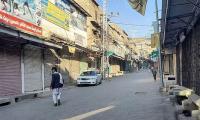air quality installed in 2007 in five major cities shut down in 2010. The Japan International Cooperation Agency (JICA) had provided Pakistan a grant of $1,233 million to set up these monitoring stations with a warning that sustainability of these stations depended upon uninterrupted maintenance and supply of kits for laboratory tests. However, this advice fell on deaf ears.
In Karachi, Quetta and Islamabad, air monitoring stations are still non-functional. In Peshawar, the station has been restored last year. In Lahore, after having remained closed for three years, the two stations were made functional in 2014 but currently they are working at half their capacity for want of repair and maintenance; eight out of 18 analysers in these monitoring stations are out of order. The mobile station in Lahore does not even have a driver to run the vehicle.
The Punjab government doles out billions on luxury projects but cannot spare a small amount of Rs2.5 million needed for annual repairs and maintenance to keep them fully functional. Compared to our dismal state, 320 air monitoring stations are working all over India, 70 in Iran and 26 in Dubai.
The environment is quite low on the priority list of our provincial governments. For example, in FY2014-15, the Punjab government allocated an annual development budget of Rs190 million on environment projects but spent only Rs20 million (10.5 percent of the total). The same was the case in the preceding year 2013-14, when the Punjab government had spent only Rs47 million on the environment projects out of an original allocation of Rs164 million.
In 2008, the Federal Ministry of Environment had formulated a Pakistan Clean Air Programme (PCAP) but it proved to be non-starter. Following the 18th Amendment in April 2010, the subject of environment was devolved to the provinces which put the clean air initiatives on the backburner.
The rapidly increasing number of motor vehicles has increased the amount of nitrogen oxides whose value has been found to be four to six times more than the normal value in big cities like Lahore and Karachi. This can be checked by enforcing strict standards of emissions on motor vehicles. We need to adopt Euro-5 and Euro-6 emission standards if we need to save our future generations.
One major reason of the high levels of sulphur oxides in ambient air of big cities and on highways is that sulphur content in diesel in our country is about one percent – which is much higher than the 0.03 percentage in Europe. The government needs to fix new standards for sulphur content in diesel being used in our country.
Air pollution is not only contributing to increased respiratory and heart diseases but the haze and fog in winters in many parts of the country also bring life to a standstill. As the winter sets in, dense layers of fog envelopes most parts of Punjab for up to 16 hours a day.
A study by the Pakistan Space and Upper Atmosphere Research Commission (Suparco) in 2007 pointed out that it is not only motor vehicles but coal-fired power stations in neighbouring Indian Punjab that are responsible for fog in our side of Punjab.
In Indian Punjab, 14 thermal units of coal-fired plants burn 13.6 million tonne of coal annually, releasing huge quantities of flying ash and sulphur dioxide into ambient air. Because of proximity and wind factor, these coal plants are causing air pollution and dense fog.
The long hours of fog have caused huge economic losses as it results in stunted growth of plants and reduced activity owing to low visibility on highways. But no government has ever bothered to take up this issue with the Indian authorities.
The overall approach of the authorities and the civil society is to ignore environmental issues. We are paying a high price for this neglect in terms of massive spending on health problems, and will pay a still higher price in the days to come if this attitude does not change for the better.
Email: adnanadilzaidi@gmail.com
Most recently, US presidential elections demonstrated how AI has amplified partisan split
Few years ago, Pakistan ranked as fourth-largest freelancer market globally, with potential to become number one
Arts Council Karachi celebrated its 70th birth anniversary at inaugural session with big cake
There are over 11 million Pakistanis settled abroad, out of which around six million work in Gulf and Middle East
This year alone, US Treasury would have to roll-over $10 to $14 trillion in maturing short-term debt
Tear gas no longer marks just protest sites; it paints entire cities as battlegrounds but then again, PTI did it first







